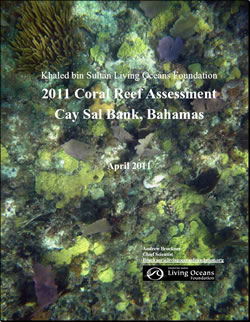Cay Sal Bank, Bahamas Field Report
(2011)
Please find an excerpt of the full PDF below
Between April 25-May 18, 2011, the Khaled bin Sultan Living Oceans Foundation (LOF) and our partners assessed the coral reefs and associated habitats of Cay Sal Bank, Bahamas as part of the Global Reef Expedition. The mission encompassed 20 days at sea at 8 different anchorage locations around Cay Sal Bank. This is the field report resulting from that mission.
2011 Coral Reef Assessment of Cay Sal Bank, Bahamas
 Khaled bin Sultan Living Oceans Foundation
Khaled bin Sultan Living Oceans Foundation
May 2011
By Andrew W Bruckner
The team included LOF scientists, staff and graduate fellows, NOVA Southeastern University’s National Coral Reef Institute (NCRI) scientists, Atlantic and Gulf Rapid Reef Assessment scientists and partners, and representatives from the Bahamas National Trust, Bahamas Department of Marine Resources, and The Nature Conservancy, Bahamas. The ground-truthing team surveyed 684.8 miles of the Bank and collected over 1.9 million depth soundings and 565 underwater camera drops along the track to verify habitats against the satellite imagery. They also collected 79 sediment samples and ran 26 sub-bottom tracks to characterize the underlying topography of the bank. The dive team surveyed 39 unique locations around the bank, conducting a total of 508 individual SCUBA dives for a total of 22,000 minutes of submerged observations. SCUBA assessments focused on
- characterization of the benthos including substrate type and cover and biomass of benthic organisms;
- coral community structure, population dynamics and health;
- fish community structure; and
- resilience indicators including extent of herbivory, patterns of recruitment, prevalence of diseases and other stressors and patterns of coral reef recovery. Additional physical parameters including salinity, temperature and current profiles were assessed around the perimeter of the bank.
Eight benthic habitat classes were identified on Cay Sal Bank: sand flats, sparse seagrass, dense seagrass, coral bommies, patch reefs, scoured hardgrounds, shelf-edge buildups and sand shoals. Coral reef habitat types were found within the lagoon and surrounding the perimeter of the bank. Unique circular seagrass patches formed atop infilled sinkholes and around man-made structures; these contained unusually large aggregations of commercially important reef fishes.
